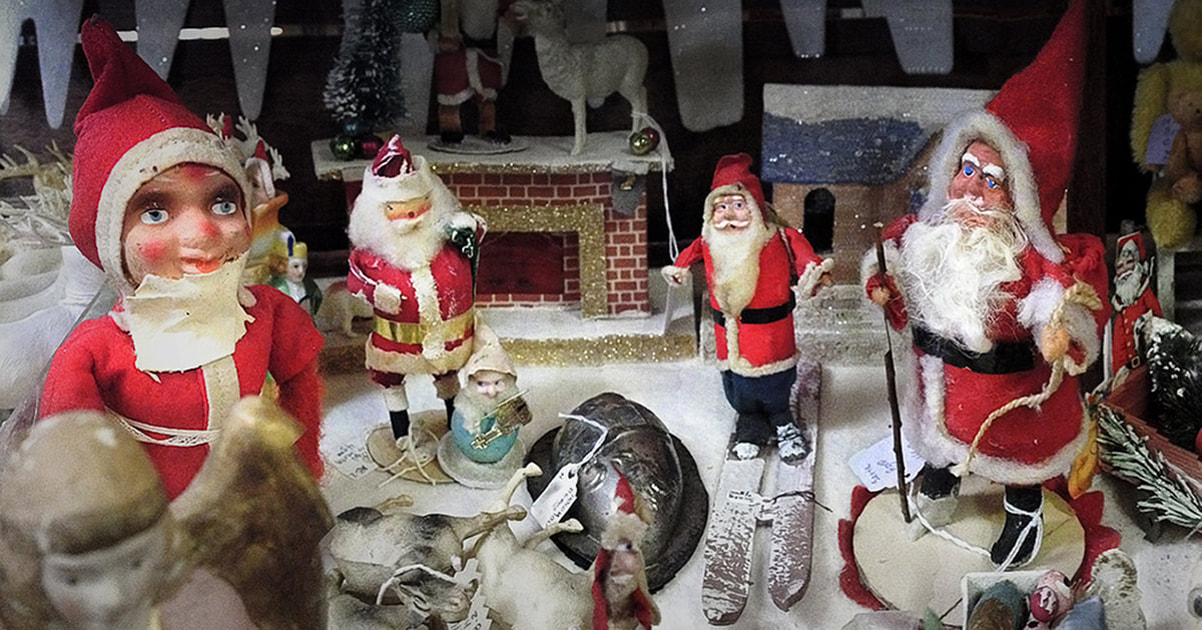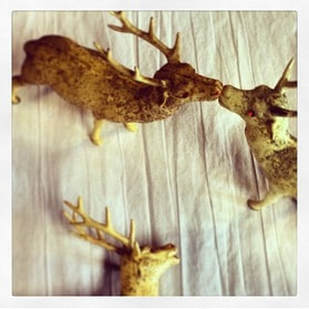This guide to vintage ornaments and Christmas decorations is sure to start a few new collections for those wanting to spice up - or spook up - their holiday decor.
- by Martha Whitney Butler
Either way, these terrifying treasures fetch a high price from collectors all over the world. Thinking about starting a vintage Christmas collection? Check out this beginner's guide to collecting vintage Christmas décor and then hit up that old box in the attic AND your local antique and vintage shops to get started!
German Christmas Ornaments
In the beginning of the annual tradition of Christmas, ornaments varied, from fruits and cookies to pure silver tinsel. It wasn't until the mid-1800s that the spirit of Christmas began its major revival with the help of holiday propaganda via Queen Victoria and Charles Dickens. Around that time, German artisans set a successful trend with hand-blown glass and embossed cardboard ornaments. These can be found in a variety of shapes, sizes, and functions. A sought-after version of glass ornaments is a "kugel," often found in a grape cluster or fruit shape. Cardboard ornaments from Dresden, Germany were a hit as well, and are highly coveted among today's collectors. It's rumored that F.W. Woolworth tested the waters with cost-effective glass Christmas ornaments from a small German village and capitalized on the cottage industry by introducing them in his chain stores. This started a movement of mass production, so when seeking out these ornaments, keep in mind the delicate, hand-blown ones without a mold seam are the most valuable. More German ornaments and décor include paper mâché Santas, candy containers, spun cotton elves, and chalkware nativity figurines. But perhaps one of their most notable productions is of a mythical Christmas figure often dismissed as a traditional Santa or elf - the dreaded Belsnickel.  German Belsnickel statue (note the walloping stick and tree branch) German Belsnickel statue (note the walloping stick and tree branch)
Belsnickel was a helpful acquaintance of Santa who visited German children in the weeks prior to Christmas. Unlike the friendly pushover Santa Claus, Belsnickel carries a single branch that he uses to beat greedy, misbehaving children. He visits door to door, village to village, bearing the gift of beating and a sack full of candles.
In true "good cop/bad cop" fashion, he throws the candles at the feet of the "good" children and sternly raps the knuckles of those too anxious to take their gift. After his abusive reminder to refrain from succumbing to avarice, he sends Santa in later to make nice with the kiddies by showering them with gifts. Some traditions are better left across the pond... Or are they? When searching for the rare Belsnickel, look for paper mâché, chalkware, and cardboard German versions. As quickly as these imported seasonal sensations became affordable to the masses, their prices began to climb due to trading complications and the growing threat of war with Germany. Manufacturers like Woolworth's began to seek other alternatives to cheap production and turned their attention to the East.
Japanese Christmas Ornaments
Japanese manufacturers were the kings of knock-off kitsch and immediately started filling orders for shiny glass ornaments, paper mâché Santas, and cardboard candy containers. Instead of traditional German pastels, the Japanese preferred bright, shiny colors in their glass production. They can even be credited with the creation of cardboard Putz houses and Santa dioramas.
While still very collectible and valuable, Japanese Christmas décor is the most common vintage find because it was available at every five-and-ten store around. With the overseas sweat-shop labor, they were very affordable to the masses. When the US entered World War II, these imports fell out of favor in the States and manufacturers began to seek American-made products.
American Christmas Ornaments
With American glass production at an all-time high, glass companies were interested in the mass production of these delicate decorations. Glass makers like Corning were mass producing millions of wholesale orders, and companies like Shiny Bright began to get in on the action.
At the beginning of the war, the nitrates used to silver and shiny up the ornaments became scarce and ornaments were a little less bright and shiny. These ornaments and those marked "Made in Occupied Japan" appeal to collectors because they serve as a wartime reference.
Retro Christmas: The 40s and 50s

In this era we begin to see the usage of plastics like celluloid, rubber, hard plastic, and glitter. Lots of glitter. Tinsel trees started to pop up in homes all over the country and bubble lights decked the weary branches of over-burdened trees.
Safer than candles, these strands of multi-colored lights brought the ultimate wow factor to the Christmas scene. Mall Santa seemed to ditch the scary paper mâché mask for a more realistic white beard... and children still cried when they sat in his lap. Serial Killer Santa with the angry rubber face was a favorite stuffed toy for kids all over and a less-breakable plastic nativity scene became the household preference. Christmas spilled out into lit-up lawns and the neighborhood competition heightened. Among the most fun collectibles from this era are feather trees, tinsel trees, and figural light bulbs.
While this guide touches on a few easy Christmas collectibles, it barely scratches the surface. Visit your local antique shops and consult with local experts on the various vintage décor. You're sure to find items to add to your collection and, if you're lucky, a creepy elf or two.
Questions about your vintage Christmas décor? Email Martha Whitney Comments are closed.
|
Categories
All
Archives
July 2024
|
Shoofly Magazine Partners
Our Shoofly Partners are local businesses and organizations who share our mission to enrich community life in Bay St. Louis, Waveland, Diamondhead and Pass Christian. These are limited in number to maximize visibility. Email us now to become a Shoofly Partner!








































 RSS Feed
RSS Feed























